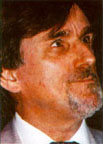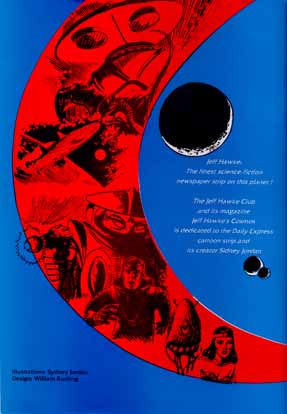 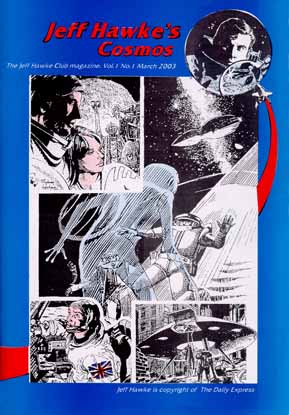
|
 
|
|
© The Daily Express JH's COSMOS Vol. 1 - No.1 March 2003 President: Sydney Jordan Editor and Designer: William Rudling |
SPACE RIDER H0001-H0138  SJ - First Part SJ - First PartRIP VAN HADDOW H2885-H2950  WP WP |
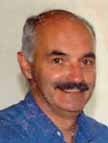 Dear Member, Dear Member,Welcome to the Jeff Hawke Club and our club magazine: Jeff Hawke's Cosmos. Thanks to your support and Adam Williams of The Daily Express, Sydney's agent Peter Knight, Ilario Vernelli and Gianfranco Goria, great and loyal supporters for many years, and archivist Terry Imrie, Jeff Hawke can fly once more. Sydney and I have plans and ideas for the club: One idea is for an annual dinner where we can meet enthusiasts of the famous strip. Another idea suggested by professional model-maker Chris Tubb is the creation of range of model figures of the leading Jeff Hawke characters. Chris will launch a new model figure for each issue of Jeff Hawke's Cosmos. Chris has already created a model of Chalcedon for this issue. We would also welcome your ideas, comments and suggestions. A letter page will be added to the next issue of Jeff Hawke's Cosmos, to give space to air your views. |
| William Rudling |
|
|

|
| by Sydney Jordan |
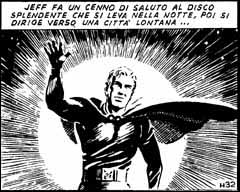 Jeff Hawke first appeared in "The Daily Express" in February of 1954, but the influences that shaped the ethos of the strip were laid down earlier, in a decade that began with victory In Europe. Morale in Britain had been bolstered up by - among other things - the efforts of people drawn from the worlds of art and academia, who, with government sponsorship, produced a steady flow of propagandist - but strongly literary and artistic - books, films and radio broadcasts which, to a child of that time, seemed like a second education!
Jeff Hawke first appeared in "The Daily Express" in February of 1954, but the influences that shaped the ethos of the strip were laid down earlier, in a decade that began with victory In Europe. Morale in Britain had been bolstered up by - among other things - the efforts of people drawn from the worlds of art and academia, who, with government sponsorship, produced a steady flow of propagandist - but strongly literary and artistic - books, films and radio broadcasts which, to a child of that time, seemed like a second education!For example, "The Aeroplane Spotter" was a fortnightly publication for The Royal Observer Corps, whose members' awesome powers of aircraft recognition augmented the insufficient coverage of the embryonic radar systems. A thin little paper of ten or twelve pages, printed on recycled newsprint and carrying half-tone photos and black-and-white illustrations, it nevertheless aired some revealing editorials, and also made use of poetry in captioning the front cover photograph. Under a shot of a wartime transport aircraft - and anticipating the coming boom in civil aviation - there appeared these magic and prophetic lines from Tennyson's "Locksley Hall": dropping down with costly bales..." Imagine the effect of this on a teenager with a passion for poetry and aeroplanes! No concession to illiteracy or ignorance here, and certainly none in Olivier' s "Henry V" of 1945, or in the wonderfully arch propaganda of the British-American confrontation between Roger Livesey and Raymond Massey in the stunning celestial courtroom scene (set in the Andromeda Spiral! ) which is the climax of the film "A Matter Of Life And Death". All this celebration of heroism, camaraderie and poetic vision, stemming as it did from the creative talents of a nation otherwise impoverished by war, was to make a lasting impression on many people, and I was to see its effect in action when, in 1945, I attended a technical school for would be aeroplane designers, which Miles Aircraft of Reading had set up as a breeding-ground for new recruits to what would be a burgeoning aircraft industry. Values and precepts of the wartime years were given an eclectic education, which not only covered all aspects of the aviation technology of the time, but included lectures and informal discussions on politics, ballet, cinema, and theatre (Mrs 'Blossom' Miles was a member of the Forbes-Robertson family, famous in the world of theatre before the war). The sense of Britain moving forward into a new egalitarian era was so strong that even today, when I meet my fellow students from those far-off days, they still ponder on just when, somewhere in the late fifties, the promise of this new utopia slipped away! For myself, and for Willie Patterson, who was to join me again later as co-scriptwriter on Jeff Hawke in 1956, this was a defining moment in our lives - coming as we did from the relative isolation of a small scottish town and apart from giving us a sound understanding of aviation engineering, our sojourn at Miles opened a window on another world, the landscape of Rupert Brooke's 'England, her sights and sounds, dreams happy as her day...' The lush green Berkshire countryside, the salubrious inns, and the beautiful Edwardian mansion in which we 'foreign' students were domiciled, all spoke of an enduring stability, which the war was unable to destroy. The school was situated at the boundary of Miles Aircraft's airfield at Woodley, and we were visited by many of the new aircraft being built by Britain's aircraft companies - and even by captured Luftwaffe planes! On one memorable occasion a whistling shriek heralded the arrival of a Messerschmitt 262, which made a low-level pass - and then gave notice of things to come by climbing vertically into the cloud-cover, with a sound of thunder... 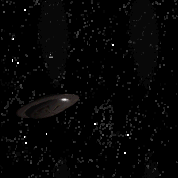 To those born after the 'jet age' this will seem run of the mill, but the war had been fought, for the greater part, by propeller-driven aircraft (many of which were built with wood!) and to witness such a demonstration in 1945 was heady stuff indeed! To those born after the 'jet age' this will seem run of the mill, but the war had been fought, for the greater part, by propeller-driven aircraft (many of which were built with wood!) and to witness such a demonstration in 1945 was heady stuff indeed!These images and influences stayed with me, and by the late forties and early fifties the eerie science-fiction of Ray Bradbury and the fabulous space and planet scapes of Chesley Bonestell, whose sense of drama and prophetic vision showed the wonders awaiting us in the Solar System, added to the background against which Jeff Hawke was to act out his adventures. The triggering factor in my creation of the comic strip was, however, the advent of the "flying-saucer" phenomenon. By linking the first story to the contemporary newsworthy nature of the 'sightings' it was possible to make a 'space' connection - at a time when rocket science was still in its teething stage. Max Aitken, Lord Beaverbrook's son, had been a fighter - pilot during the war, and in 1954 he was effectively running "The Daily Express", and had a number of his Air Force friends working at administration level. 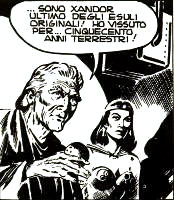 The strip's opening sequence - of Hawke in RAF uniform struck a chord with them, this, coupled with a 'spirit of the age' script, and a technically-plausible portrayal of the aircraft and the flying saucer, as enough to sell the idea. Hawke's abduction by aliens in the first story, followed by the exploration of themes such as alien visitations and buried or hidden extraterrestrial artifacts, were to be taken up by Von Daniken and others some years later, and this tendency for the strip to anticipate other writers' work is perhaps best exemplified by the 1958 story,
OUT OF TOUCH The strip's opening sequence - of Hawke in RAF uniform struck a chord with them, this, coupled with a 'spirit of the age' script, and a technically-plausible portrayal of the aircraft and the flying saucer, as enough to sell the idea. Hawke's abduction by aliens in the first story, followed by the exploration of themes such as alien visitations and buried or hidden extraterrestrial artifacts, were to be taken up by Von Daniken and others some years later, and this tendency for the strip to anticipate other writers' work is perhaps best exemplified by the 1958 story,
OUT OF TOUCH  , in which a huge 3 mile - long spaceship enters the Solar System. Mysterious, deadly, (its outer hull being constructed of antimatter) the ship is in fact a self-contained world known to its inhabitants as RHAAM. , in which a huge 3 mile - long spaceship enters the Solar System. Mysterious, deadly, (its outer hull being constructed of antimatter) the ship is in fact a self-contained world known to its inhabitants as RHAAM.15 years later Arthur C.Clarke's "Rendezvous with Rama" carried distinct echoes of name. Of course, there was no plagiarism here - Clarke being the master of prophetic storylines are seldom the exclusive products of a single mind. Timing is the governing factor, and it was the choosing of a specific date that gave the strip a wider recognition in 1969. 10 years before that, in a story set on the Moon, I had illustrated one panel with a drawing of a sculpted pillar of moonrock carrying a metal plaque, which grandly proclaimed:  "ON AUGUST 4th EARTH YEAR 1969 THE FIRST BEING SET FOOT ON THE MOON AT THIS POINT... HIS NAME WAS HOMO SAPIENS."  The prediction was only two weeks out from the actual date (July 21st, 1969), and was picked up by some faithful readers, resulting in 15 (or so) minutes of television fame in the company of James Burke and Patrick Moore! To come within 14 days of the event from 10 years previously was a happy chance, but my choice of the year 1969 was based on my knowledge and understanding of the potential of american/german spaceflight engineering which, in turn, stemmed from the days spent at Miles Aircraft. The prediction was only two weeks out from the actual date (July 21st, 1969), and was picked up by some faithful readers, resulting in 15 (or so) minutes of television fame in the company of James Burke and Patrick Moore! To come within 14 days of the event from 10 years previously was a happy chance, but my choice of the year 1969 was based on my knowledge and understanding of the potential of american/german spaceflight engineering which, in turn, stemmed from the days spent at Miles Aircraft.This ability to wed fiction to reality could still be seen when Willie Patterson joined me in creating a more fantastic series of adventures, involving the complex social hierarchy of 'The Galactic Federation', with its policemen, villains, judges and commoners. Although these stories carried dark undertones, there was never any gratuitous nastiness - indeed it's the humour that comes across most strongly, and the feeling that these grotesque creatures are plagued with many of the same problems from which humanity suffers. Willie, remembering our earlier encounters with the more sophisticated milieu of southern England, based the pecking - order of his aliens on the various relationships that existed within the Miles school, subsequently at Amalgamated Press in London, where he worked for some time as an editor. The sheer originality of his story ideas ensured the stripes success in the period between 1960 and 1969, and fans in Italy, who could read the entire opus in hardback books published there, refer to this period as 'The Golden Age'. The combination of unique characters, dense plotting and wall-to-wall drawing, brought a convincing realism to a subject which was still fairly radical in terms of a general newspaper readership. For some months 'The Express' ran the strip under the banner 'Jeff Hawke, First Citizen Of The Space Age' - in recognition of the fact, previously mentioned, that his adventures kept pace with - and often anticipated - current progress in astronautics. To this day, middle-aged science-fiction authors and artists tell me that, when they were young, Jeff Hawke was their 'bible' and inspiration! I like to think that a new generation will enjoy Jeff Hawke - and the future 'The Movie'? |
|
|
© Sydney Jordan 2003
